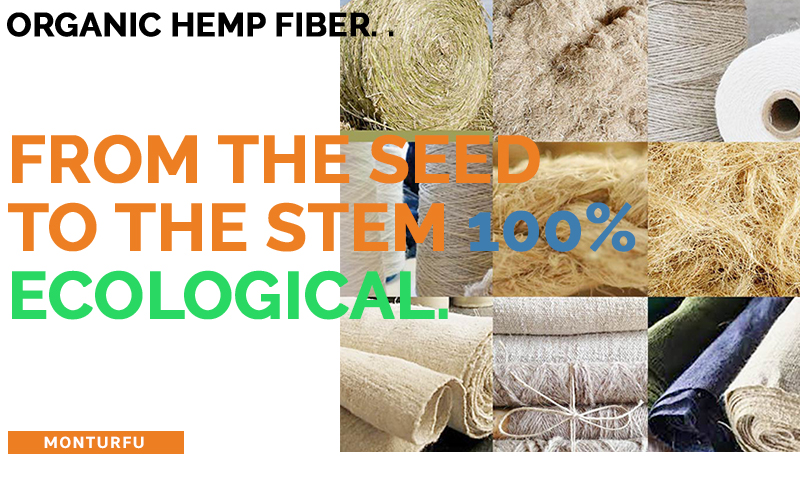ORGANIC HEMP FIBER.
FROM THE SEED
TO THE STEM 100%
ECOLOGICAL.
France is the first producer of hemp in the European community with a surface of 17 900 ha in 2020. It is the man of the prehistory who tamed the hemp first. Moreover, it is a member of the family of fiber plants. Hemp is cultivated between spring and autumn. And from the stalk to the seed through the fiber, nothing is lost, everything is transformed.
In essence, hemp is used in food, health and construction.
Organic hemp fiber in the modern era.
The ecological footprint of fashion is no longer a surprise to anyone. Moreover, the explosion of fast fashion at the beginning of the 2000’s totally overshadowed at first this negative aspect of fashion on nature. Then, little by little, the general public is totally seized of the ecological footprint of fashion. They investigated and discovered that synthetic fibers are not biodegradable and that thousands of tons of them are found in the oceans and in the stomachs of all aquatic fauna. And on the other hand, conventional cotton is almost treated with GMOs and exhausts the earth of its water resources.
Hemp has a special history with France.
Hemp is an ancestral crop in France. Historically, Maine-et-Loire is a region favorable to the production of its seed. Note : the French department of Maine-et-Loire, 49 is a territory that largely takes up the limits of the former province of Anjou, registered since 2000 on the UNESCO World Heritage list. And above all, if today the hemp culture is revitalized all over the world, it is thanks to this French exception which has never ceased to recognize its intrinsic values in this plant.
Paper saves hemp.
In the 1960s, the authorities prohibited the use of recovered textile fibers for the extra fine paper industry, especially in the manufacture of cigarette paper. Because there are nylon and synthetic fibers in the recycled textile. This decision directly benefits the hemp industry and thus boosts its production. Let us also note that there is another factor which directs this decision in this direction. And it is among other things the manufacturing of high quality writing papers.
The cultivation of organic hemp fiber.
Hemp is part of a unique family in agriculture. Because it breaks the cycle of diseases. Like all spring crops, hemp dissolves fall crop rotations and inhibits the reproduction of weeds that are nothing more than weeds.
Hemp cultivation actively participates in the increase of ordinary, animal and plant biodiversity throughout its cultivation cycle.
Naturally resistant to many diseases, the presence of this biodiversity does not harm its growth. It can therefore easily reach 5 meters in height. With its deep roots, hemp plants aerate the soil for the following crops. The cultivation of hemp also fights against hydromorphy, increasing the carbon content of the soil.
The hemp fiber is 100% organic.
Hemp is an ecological plant because it reduces the IFT, Indicator of Frequency of Phytosanitary Treatments in vegetation. It also consumes little water, inputs and mechanical work… Thus its cultivation does not require irrigation and is not sensitive to lodging. It favors the development and the action of the soil microflora and microfauna. This action is a guarantee of its good functioning.
An extremely resilient plant.
In organic as well as in conventional farming, hemp is almost insensitive to diseases and insects. It does not need any fungicide or insecticide. And in good conditions, it is a smothering plant that requires no weeding, neither chemical nor mechanical. The cultivation of hemp can easily be included in a rotation in organic agriculture.
What are the advantages of growing hemp ?
Europe cultivates hemp mainly for :
- its seed, rich in Omega 3 and 6, proteins and vitamin E
- in human food, we have the hemp butter from the Baltic countries for example, or as a food supplement for cattle or poultry; these products improve the fertility of males, its biochemical molecules of pharmaceutical interest, its fiber, the phloem,
- the agro-materials sector uses the fiber, the chenille and the xylem for the building industry, composite materials, geotextiles, mulch and paper,
- and oil has a very good reputation for paints.
Finally, many etymological traces, popular expressions and said places are still present for example, canevas, Cannebière, chènevière, cravate de chanvre…
The textile and clothing industry.
More and more actors are involved in the reconstruction of this sector. Thus, we can see here and there, the techniques to work either the long hemp fibers, or the semi-long fibers, or the short cottonized fibers and or the cellulosic fibers of hemp.
The LCBio association is an actor in research and development.
The LCBio association is an actor in research and development. It has the support of :
- the Water Agency,
- the DRAAF and the French region of Normandy.
Since 2017, LCBio has been active in the implementation of manufacturing process of long hemp fiber quality and research of mechanical solutions for harvesting.
The beginnings of the mechanization of this local initiative.
At the end of 2018, the association conquers a Chinese mower/parallelogram that it adapts to its mowing requirement. After some modifications and the manufacture of a cutting disc, the association achieves its goals and holds its meter of stem at mowing.
The beginnings of a local ecosystem.
LCBio and its different partners validate the different steps, from mowing to the manufacturing of a prototype of a 100% hemp jean, including spinning, weaving, cutting and sewing… This jean wins the 2020 prize of the jury’s favorite of the bio economy trophies. The association then offers its product to its members and closes the orders on new perspectives. From now on, the association has grown from 12 ha to 15 ha of trials, and can now count on new partners, including the scutching cooperative of the Neubourg plateau.
LCBio organizes in January 2021 a hemp spinning commission, a meeting of specialists. Rightly so, it is the first one in France since the post-war period.
The transfer of technologies used in the cultivation of flax.
These machines are very specific to long fiber and do not exist anywhere else in the country other than in the linen basins.
The manufacture of organic hemp long fiber.
After mowing the hemp plants, they are cut into 1 meter sections. Then they are laid in parallel on the mowing area. This way, the hemp stalks roll in the field thanks to the alternation of rain and sun.
The bacteria present in the water degrade the pectins instead. Pectins and hemicelluloses are molecules that glue the fibers together. The fibers themselves are composed of cellulose.
Finally, they are turned over, rolled up, dried and dyed with agricultural flax machines. And in the end, we obtain hemp fibers from 80 cm to 1 m for the rest of the process.
The making of semi-long fibers or framed fibers.
Although the techniques and processes are still in the research and development phase, semi-long hemp fibers are less demanding in terms of resource allocation. Thus, the producer does not need any specific equipment. These fibers do not require the paralleling of hemp stalks in the field. This saves time and energy. The bundles of framed fibers are spun pure. However, the fibers are not as fine as with long hemp fibers. In general, they measure between 25 and 40 centimeters.
The spinning of short organic hemp fibers.
The short hemp fibers also do not need to be parallelized from the stalks. After the process of separating the fibers from the hemp stalks, the defibration is chopped and refined to suit cotton spinning. We then obtain short fibers. Moreover, they are spun by mixing them with other materials, in this case cotton. This process produces fiber bundles of 3.5 to 5 centimeters.
Organic hemp fiber in history.
In the first decade of the second half of the 19th century, in 1850, hemp occupies 10 times more surfaces than today. Its presence in the textile industry is strong. Just because the hemp fiber has a great longevity in water, the sailing navy makes it its essential material. On the other hand, hemp was widely used in the making of clothes and household linen in the working classes.
At that time, the European elites only had eyes for silk and almost everyone was unaware of the existence of cotton. Hemp fiber was indeed omnipresent in the society of the time.
The steam engine and synthetic fibers downgrade organic hemp.
The more society evolves, the less we need animal and wind power to go about our daily business. The use of the rope and the sail falls then more and more in economic obsolescence. Thus, Denis Papin’s work on the steam engine in 1690 marked the beginning of the decline of hemp. The rupture appears obvious with the advent of the explosion engine. However, periods of war and conquest, notably the gold rush, temporarily maintained the practical usefulness of hemp fiber.
The disruptive irruption of nylon.
From the end of the 18th and beginning of the 19th centuries, hemp was used in clothing collections in favor of cotton. In 1935, the company Dupont de Nemours creates nylon. And there, it is the fatal blow of grace. The nylon declasses and supplants completely the hemp. Thus, even in rope, hemp no longer has its place. Its executioner and replacement in ropes weighs the same before and after its stay in water. Rotproof, odorless, and elastic on top of that. The hemp touches the bottom and disappears in Europe, except in France.
The new opportunities.
The valorization of hemp chips by the hemp industry has been a real success in the 1980s. The hemp is light and porous, which reduces the concentration of pathogenic germs in racehorse stalls. Its success extends from Enghien in France to Dubai. The hemp, which represents 55% of the weight of the straw, has gone from being a by-product to being a co-product of the fiber and the seed.
Moreover, it is increasingly used in distributed insulation construction systems and represents 0.3% of the construction market.
Organic hemp fiber is conquering new markets.
The Lacoste group is involved in ambitious research programs to recreate a hemp-based textile industry in France. On the other hand, since 2000, hemp fiber panels have been developed as construction insulation, perfect substitute for mineral fibers, glass wool, rock wool. They represent today a third of the uses of the fiber. In the same way, they are integrated more and more in reinforcement parts for the automobile, inside doors, dashboard, bringing lightness and rigidity. Concretely today, all the vehicles of tourism of the mark Peugeot integrate hemp.
The hemp seed.
The nutritional interest of hemp seeds is nowadays a consensus. Because its protein fraction is very useful for vegetarian diets, and lipidic. Its omega 6 / omega 3 ratio of 4/1, is close to the ideal ratio which is 3/1. Consequently, the multiplicity of uses of hemp are a guarantee of continuous improvement of the sector and a securing of the investments towards the implementation of a serene economic model.






Laisser un commentaire